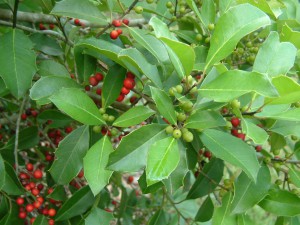
The Savannah holly has beautiful leaves and berries throughout the winter. Photo credit: Carrie Stevenson
As the holiday season comes upon us, many folks will be spending their weekends scouring tree farms and mall parking lots for the perfect Christmas tree. There are many very realistic-looking options for artificial trees these days, and they are a great way for families to reduce waste by reusing the same tree year after year. However, a live Christmas tree brings greenery inside, smells wonderful, and provides a central focus for many of our holiday traditions. Many cut trees will last over a month with good watering, but when the holidays are over, what do you do with your tree?
Many cities and counties offer a Christmas tree recycling program, in which trees can be left at drop-off sites or on the curb for pickup. Most municipalities turn the trees into mulch and use it at public facilities. Many individuals reuse trees by placing them in lakes or other water bodies as fish habitats, creating reefs for hiding and nesting. However, be sure and check with local environmental agencies before placing trees under water. If you own a good bit of land or a wooded area, you can lay your old tree out for small mammals and birds to use as shelter. It will eventually biodegrade and add nutrients to the soil. Be sure that if you take advantage of any of these recycling options that you remove all ornaments, tinsel, or other decorations which could be hazardous to animals and/or wood-chipping machines.
There is an option to truly keep your tree evergreen—a live Christmas tree! Many retailers sell potted trees that can be brought inside and decorated, then planted outside after the season is over. One of the plants often associated with this festive time of year is holly, which is an excellent choice for evergreen color throughout the year. There are many native varieties, such as yaupon holly for drier areas and myrtle-leaved holly for wetlands. Hollies are typically used as shrubs in the landscape, although many species can grow into small trees if allowed; the East Palatka holly can be as tall as 45 feet at maturity! Hollies are also an excellent food choice for attracting birds, and the shrubs work wonderfully as a natural screen. While their branches aren’t quite as sturdy as some of the northern varieties, native Atlantic white or Eastern red cedar–or even some local pines–are also excellent evergreen species that can be used.
A live tree or one planted and decorated outdoors is a wonderful way to commemorate a special Christmas and help provide wildlife habitat year-round.
- Yucca–A Tough and Versatile Native Plant - November 26, 2025
- Blazing Star - November 6, 2025
- University of West Florida’s New Heritage Roots Garden - October 17, 2025
